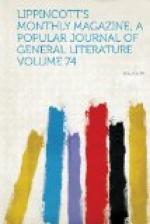The manner in which the Parsees dispose of their dead seems to us too shocking to be tolerated by a people so gentle and refined. But they have grown familiar with a custom that, generation after generation, has been observed by their race till it has ceased to be repugnant. They call it “consigning the dead to the element of air.” For this purpose they have roofless enclosures, the walls of which are twenty-five or thirty feet high, and within are three biers—one each for men, women and children. Upon these the bodies of the dead are laid, and fastened down with chains or iron bands. Presently birds of prey, so numerous within the tropics and always waiting to devour, pounce upon the corpse and quickly tear the flesh from the bones, while the skeleton remains intact. This is afterward deposited in a pit dug within the same enclosure, and which remains open till completely filled up with bones; after which another is dug, and when the enclosure can conveniently contain no more pits a new one is selected and prepared. None but priests and bearers of the dead may enter, or even look into, these walled cemeteries. The priests, by virtue of their holy office, are preserved from defilement, but the bearers are men set apart for this express purpose, and they are considered so unclean that they may not enter under the roof of any other Parsee or salute him on the street. If in passing a bearer do but touch one’s clothes accidentally, he is subject to a heavy fine, while he who has been thus contaminated must bathe his entire person and burn every article of raiment he wore at the time of his defilement.
I was anxious to visit one of their temples, but this, Sir Jamsetjee assured me, was impossible, as none but the initiated are allowed even to approach the entrance, still less to get a glimpse of what is passing within. He, however, volunteered the information that, so far as the sanctuary itself was concerned, there was little to be seen, only naked walls, bare floors, and an altar upon which burns the sacred fire brought with the Parsees from Persia, and which, he said, had never been extinguished since it was kindled by Zoroaster from the sun four thousand years ago. Of the form of service I could not induce the baronet to speak, but I learned afterward from my ship-friend that the altar is enclosed by gratings, within which none but the priest may enter. He goes in every day to tend “the eternal fire,” when he must remain for the space of an hour, repeating certain invocations, with a bundle of rods in his hand to repel any unclean spirits that should venture to approach the sacred fire. Meanwhile, the assembled multitudes prostrate themselves without and offer up their silent adoration. “Yet, after all,” musingly said the Parsee, “the universe is the throne of the invisible God, of whom fire is but the emblem, and we worship Him most acceptably with our eyes fixed on the east when the sun rides forth at morning in his celestial chariot of fire.” This form




